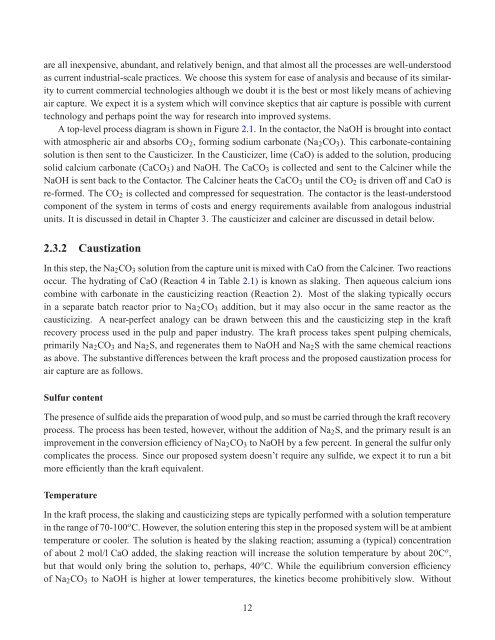Capturing CO2 from ambient air - David Keith
Capturing CO2 from ambient air - David Keith
Capturing CO2 from ambient air - David Keith
You also want an ePaper? Increase the reach of your titles
YUMPU automatically turns print PDFs into web optimized ePapers that Google loves.
are all inexpensive, abundant, and relatively benign, and that almost all the processes are well-understood<br />
as current industrial-scale practices. We choose this system for ease of analysis and because of its similarity<br />
to current commercial technologies although we doubt it is the best or most likely means of achieving<br />
<strong>air</strong> capture. We expect it is a system which will convince skeptics that <strong>air</strong> capture is possible with current<br />
technology and perhaps point the way for research into improved systems.<br />
A top-level process diagram is shown in Figure 2.1. In the contactor, the NaOH is brought into contact<br />
with atmospheric <strong>air</strong> and absorbs <strong>CO2</strong>, forming sodium carbonate (Na2CO3). This carbonate-containing<br />
solution is then sent to the Causticizer. In the Causticizer, lime (CaO) is added to the solution, producing<br />
solid calcium carbonate (CaCO3) and NaOH. The CaCO3 is collected and sent to the Calciner while the<br />
NaOH is sent back to the Contactor. The Calciner heats the CaCO3 until the <strong>CO2</strong> is driven off and CaO is<br />
re-formed. The <strong>CO2</strong> is collected and compressed for sequestration. The contactor is the least-understood<br />
component of the system in terms of costs and energy requirements available <strong>from</strong> analogous industrial<br />
units. It is discussed in detail in Chapter 3. The causticizer and calciner are discussed in detail below.<br />
2.3.2 Caustization<br />
In this step, the Na2CO3 solution <strong>from</strong> the capture unit is mixed with CaO <strong>from</strong> the Calciner. Two reactions<br />
occur. The hydrating of CaO (Reaction 4 in Table 2.1) is known as slaking. Then aqueous calcium ions<br />
combine with carbonate in the causticizing reaction (Reaction 2). Most of the slaking typically occurs<br />
in a separate batch reactor prior to Na2CO3 addition, but it may also occur in the same reactor as the<br />
causticizing. A near-perfect analogy can be drawn between this and the causticizing step in the kraft<br />
recovery process used in the pulp and paper industry. The kraft process takes spent pulping chemicals,<br />
primarily Na2CO3 and Na2S, and regenerates them to NaOH and Na2S with the same chemical reactions<br />
as above. The substantive differences between the kraft process and the proposed caustization process for<br />
<strong>air</strong> capture are as follows.<br />
Sulfur content<br />
The presence of sulfide aids the preparation of wood pulp, and so must be carried through the kraft recovery<br />
process. The process has been tested, however, without the addition of Na2S, and the primary result is an<br />
improvement in the conversion efficiency of Na2CO3 to NaOH by a few percent. In general the sulfur only<br />
complicates the process. Since our proposed system doesn’t require any sulfide, we expect it to run a bit<br />
more efficiently than the kraft equivalent.<br />
Temperature<br />
In the kraft process, the slaking and causticizing steps are typically performed with a solution temperature<br />
in the range of 70-100 o C. However, the solution entering this step in the proposed system will be at <strong>ambient</strong><br />
temperature or cooler. The solution is heated by the slaking reaction; assuming a (typical) concentration<br />
of about 2 mol/l CaO added, the slaking reaction will increase the solution temperature by about 20C o ,<br />
but that would only bring the solution to, perhaps, 40 o C. While the equilibrium conversion efficiency<br />
of Na2CO3 to NaOH is higher at lower temperatures, the kinetics become prohibitively slow. Without<br />
12








